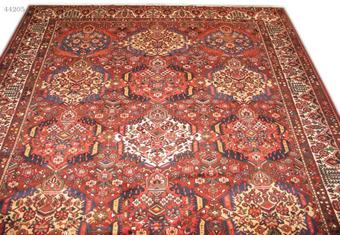Antique handmade oversized carpet No. 44205 Bakhtiari, ca. 1935 Iran 498 x 390 cm

Larger images (will open in new window)
Please click on the thumbnails below for a larger view
| main view |
close-up |
close-up of corner |
back |
 |
 |
 |
 |
| Item Number: |
44205 |
| Name: |
Bakhtiari, ca. 1935 |
| Country of Origin: |
Iran |
| Size: |
498 x 390 cm |
| Made:
|
ca. 1935 |
| Pile: |
wool |
Foundation
(warp and weft): |
cotton |
| Design: |
floral and geometric / allover |
| Ground Color: |
red |
| Knots per sqm: |
250,000 |
| Remarks: |
This is a unique handmade / hand-knotted / traditional oriental carpet
The pile of this carpet is made of wool
This carpet is in mint condition despite its age
This carpet has a total of approximately 4,855,000 knots and it took skilled carpet makers about 6,473 hours or 719 working days to hand-knot this carpet. |
 add to cart
add to cart
More about the provenance Bakhtiari, ca. 1935 | Iran
The name originates from the times when the landlords of the area were Bakhtiaris. Today Bakhtiari rugs are mainly made by peasants, therefore Bakhtiaris are not nomadic rugs as often mistakenly assumed. Bakhtiari rugs are of high uniqueness and durability.
This is an Oriental nomadic rug. The word "nomad" comes from the Greek word "nemein". Nomads are wandering tribes, shepherds, stockbreeders, or hunters. In the minorly populated areas of Asia and North Africa they move with their herds, all their belongings and their tents to new places constantly. Many states already tried to make them settle down with various success. Mostly it is the women of the tribes which contribute to the family's income with their carpet knotting and weaving while the men breed stock or go hunting. But due to the circumstances of nomadic life the carpet production often lacks regularity and precision in form and design, which actually adds to their originality and makes them even more popular. The wool is mostly dyed with vegetable dyes.
This Oriental carpet has a so called "garden design" or as in Persian "Kheshti". The design of Oriental "garden rugs" represents sophisticated garden layouts from a bird's eye view. The oldest garden rugs date back to the 16th century. The legendary rug "Spring of Khosrow" of Khosrow the Sassanide king served as a template. The rugs are divided into fields which are separated by water ditches. The ditches in which often fish and ducks are swimming are flanked by bushes and flowers. Altogether garden rugs are an expression of the special Oriental love of floral beauty which peaked in fantastically laid out gardens.

